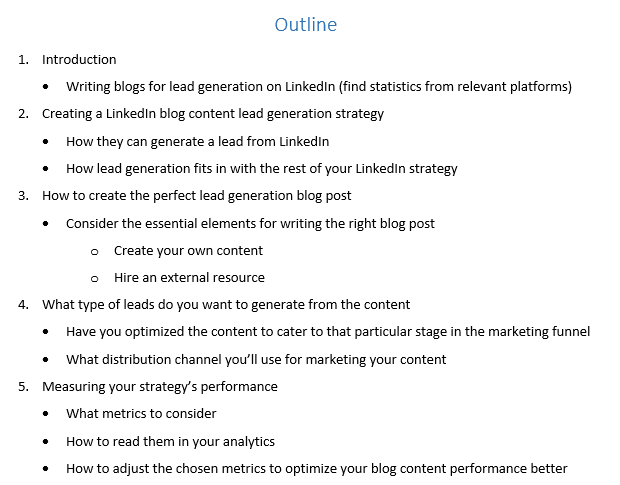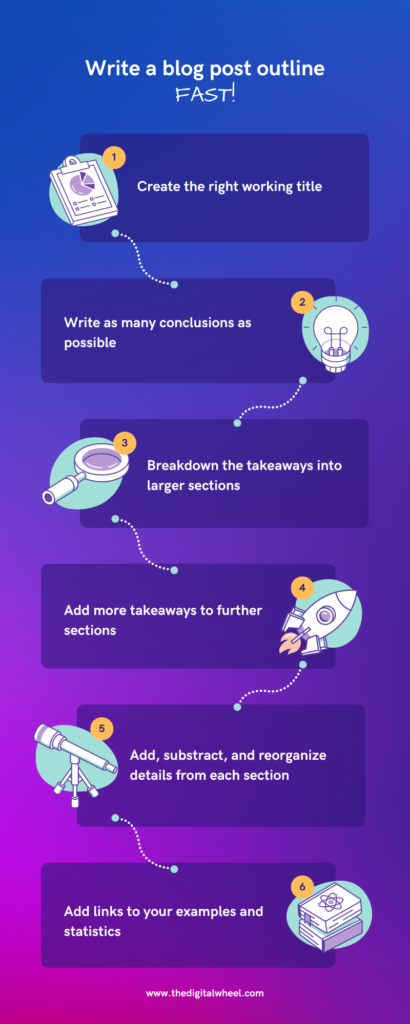What makes a blog post good or bad? I believe not learning how to write a blog post outline.
Your blog post could not be as perfect as you think due to poor formatting, bad grammar and sentence structuring, outdated facts and figures, and more.
Hence, your content’s clarity, readability, and overall value determine its success and shareability. Taking your time to craft a blog post could be the difference between someone reading your entire blog and returning in the future and someone leaving your page within ten seconds and never coming back.
This is why you need a perfect blog post crafted on a solid foundation.
How to write a blog post outline, fast!
Create the right working title
Easily the most crucial step of the entire content production process—you need to clearly understand what you’re doing before you start creating content.
Consider the example of this blog. “How to write a blog post outline,” and not “blog post outline,” the idea is to get specific for yourself and your readers.
Spend quality time crafting the right, specific title for your blog post format, but don’t stress too much.
The purpose is to give you an idea of what your actual blog will talk about; you can always refine the title later on.
Write as many conclusions from the post as possible
It’s time for the brain dump session! Put all the takeaways on paper you want your readers to acquire after reading your blog.
Write down whatever comes to mind naturally; you can always organize the sequence later.
Remember, these takeaways won’t necessarily come before your subheadings or main sections of the article. Still, as I said above, the crux of your entire discussion is what you want your readers to gain.
Consider the example of a working title, “How to use blogs to generate leads on LinkedIn” these will most probably be my readers’ takeaways.
- What is the difference between a great blog post and a poor blog for LinkedIn?
- How can users create their own content for LinkedIn?
- What tools and techniques do they need to create content?
- How often should they post content on LinkedIn?
- What are the different ways to post content?
- How can they generate a lead through LinkedIn
- How long should the social media copy be to talk about the blog?
- What results or engagement can they expect to get?
It won’t take an expert to determine that all the above takeaways are unfiltered. That’s intended; we’ll sort them in the following step.
Break down the above takeaways into larger sections
Now that we have a skeleton of takeaways, we’ll extend each pointer into overarching sections. Think of it as buying groceries; each item belongs to a different section in the supermarket.
Your brainstorming sessions should give some good themes. At times, one of the pointers will be a theme in itself. But mostly, several bullets can be put under one central theme.
Many bloggers often recommend 3 to 4 larger sections. However, it depends on the type and length of your piece.
If you’re writing a long, comprehensive 2500-word piece like the post you’re reading right now, you might need more than 3-4 sections. And if it’s a quick post, there will be fewer sections. On average, 3 to 4 sections are ideal.
Coming back to our last example of a post on using blogs to generate leads on LinkedIn, let’s start putting our random takeaways into a more organized manner.
- Introduction
- Creating a LinkedIn blog content lead generation strategy
- How they can generate a lead from LinkedIn
- How often should they post content
- How to create the right lead generation content
- What should be the ideal blog post length
- How to use the blog URL with the social caption
- How can they create their own content for LinkedIn
- What is the difference between a great blog post and a poor blog for LinkedIn?
- Measuring your strategy’s performance
- What results can they expect to see
Add more takeaways to some sections
Seemingly, at this point, your blog outline might be pretty uneven and disorganized. Some pointers have a single sub-pointer, others have a lot of sections, while some might not have anything.
It’s time to fill in the gaps made in the first outline draft. Yes, thinking about what’s missing is not an easy job but worth the effort.
Is there a point in the introduction that would make a great start? Don’t forget to add muscle to the introduction too.
Now here comes my elaborated, much better-looking blog outline. I’ve italicized the new pointers I’ve added for a better understanding.
- Introduction
- Blog content success for LinkedIn (find statistics from relevant platforms)
- Creating a LinkedIn blog content lead generation strategy
- How they can generate a lead from LinkedIn
- How often should they post content
- How to create the right lead generation content
- What should be the ideal blog post length
- How to use the blog URL with the social caption
- How can they create their own content for LinkedIn
- What is the difference between a great blog post and a poor blog for LinkedIn?
- At what stage your will your blog lie in the content marketing funnel?
- Have you optimized the content for lead generation?
- Have you determined your distribution channels?
- Measuring your strategy’s performance
- What results can they expect to see
- What metrics to examine
- How to locate those metrics in your analytics
- How to adjust the metrics for better performance and results
Now this outline is one step closer to being a post. Practically speaking, we’ve repeated the 2nd step, but only in a more managed, elaborative manner this time.
Add, subtract, and reorganize details from each section
Here comes the fun editing part, given you’ve already done the hard part of putting all the ideas on paper.
Apparently, now we’re starting to clear out the trash parts and tighten our outline by including only relevant information, revising the sub-bullets that make sense, and logically reorganizing the pointers.
I’m copy-pasting the above outline and making cuts shown in bold.
- Introduction
- Blog content success for LinkedIn (find statistics from relevant platforms)
- Creating a LinkedIn blog content lead generation strategy
- How they can generate a lead from LinkedIn
- How often should they post content
- How to create the right lead generation content
- What should be the ideal blog post length (a basic step that someone should already be aware of if they’re reading this post)
- How to use the blog URL with the social caption
- How can they create their own content for LinkedIn
- What is the difference between a great blog post and a poor blog for LinkedIn? (not a very relevant point for our core topic)
- At what stage will your blog lie in the content marketing funnel?
- Have you optimized the content for lead generation?
- Have you determined your distribution channels?
- Measuring your strategy’s performance
- What results can they expect to see (the statistics in the introduction will cover this part)
- What metrics to examine
- How to locate those metrics in your analytics
- How to adjust the metrics for better performance and results
If you’re still finding it difficult on what to cut and what not, follow two simple things: cut sub-bullets that aren’t adding any value or are too basic to cover in the post.
Now comes the reorganizing part! We’ll re-work through some sub-bullets to make them sound like actual takeaways.

Do note that I’ve added further sub-bullets under one sub-bullet for better clarity.
Add links to your examples and statistics
A time-saving trick preventing you from disrupting your flow every now and then when you start writing the actual blog.
After you’ve completely revamped and fleshed out your outline, include examples and data to support as many claims as possible.
After you find relevant sources to support your claims and examples, add them as a note underneath the section.
Why do you need a great outline?
I won’t be surprised if you feel like the above steps feel like a great deal of work put together only to create a blog outline. What will be actual blog writing like?
For some reason, writing detailed writing might give you the perfect excuse for another time-consuming obstacle to writing and publishing a blog.
I won’t disagree with you in some instances. For example, you might argue that it’s much easier to write a blog without a clear outline if the topic you’re covering isn’t obligated to follow a concrete structure and supporting research. Even simpler if the blog will mostly cover your thoughts and experiences.
In this case, we’re content with someone who’s more of a hobby blogger and not a professional one.
But when it comes to monetizing your blog and delivering a value-added experience to your audience amidst all the other competitors in your niche, no quality article originates without a solid outline first.
For further reasons, this is why you need a detailed blog outline.
Outlines help you overcome the blank page syndrome
Every writer feels intimidated after opening a blank Google Doc or Microsoft Word page. The feeling of being lost in the midst like a deer in headlights. Hence, learning how to write a blog post outline is your savior from the dreaded blank page syndrome.
A blog outline is a great way to alleviate the stress of the prospect of writing a 2000-words and above blog. It feels like building a castle by lifting a brick without having a clear indication of how and where to put it.
Outlining reduces the pressure because you’re not mandated to write an entire subheading or paragraph with short bullet points. And it’s only a matter of time before you’ll start elaborating on each bullet and get the job done.
Outlines make the editor your best friend
You can relate to this point if you’ve worked with a professional editor. Creating detailed outlines can save your butt more time than you can count.
A detailed outline will also give the client an idea of what the entire article will be about and the sections you will include.
When you and your client are on the same, the editor won’t have to fuss much over needing to do a massive overhaul.

Nail your draft
Outlines aren’t meant to be a piece of art!
Don’t expect the outline to be neat, clean, and free of grammatical errors. Moreover, don’t fuss over infusing your brand voice and tone into the piece.
Your blog outline’s purpose is to give you a direction the next time you sit down to start writing the article without the black cursor staring back at you.
These six steps will make your blog writing process less daunting, more efficient, and a great experience. Seemingly, now that we have the Google’s new helpful content update out rolling, learning how to write a blog post outline becomes ever more important.
Related content: Top 7 Takeaways from Google’s Helpful Content Update
And since I spend most of my time writing long-form content, it’s not an incremental win for me but a game changer.



